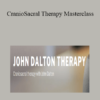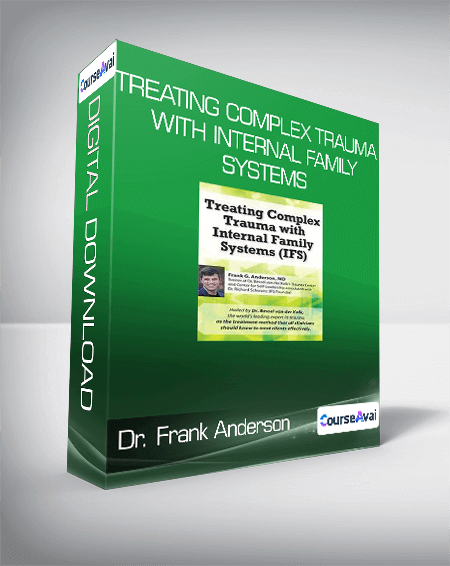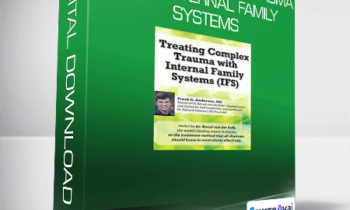$299.00 Original price was: $299.00.$111.00Current price is: $111.00.
Most modes of psychotherapy believe to have “parts” is pathological. NOT in Internal Family Systems (IFS). In IFS, the idea of multiplicity of the mind is normal. Every part has a good intention, and every part has value. Even for trauma survivors.
 Purchase this course you will earn 111 Points worth of $11.10
Purchase this course you will earn 111 Points worth of $11.10Elevate your skills with the Dr. Frank Anderson – Treating Complex Trauma with Internal Family Systems course, available for just $299.00 Original price was: $299.00.$111.00Current price is: $111.00. on Utralist.com! Browse our curated selection of over 60,000 downloadable digital courses across diverse Health and Medical. Benefit from expert-led, self-paced instruction and save over 80%. Start learning smarter today!
Most modes of psychotherapy believe to have “parts” is pathological. NOT in Internal Family Systems (IFS). In IFS, the idea of multiplicity of the mind is normal. Every part has a good intention, and every part has value. Even for trauma survivors.
Purchase Dr. Frank Anderson – Treating Complex Trauma with Internal Family Systems courses at here with PRICE $299 $111
Dr. Frank Anderson – Treating Complex Trauma with Internal Family Systems
Most modes of psychotherapy believe to have “parts” is pathological. NOT in Internal Family Systems (IFS). In IFS, the idea of multiplicity of the mind is normal. Every part has a good intention, and every part has value. Even for trauma survivors.
In the treatment of trauma, IFS is different from traditional phase-oriented treatments. Instead of starting with building resources in clients before processing traumatic memories, it welcomes extreme symptoms from the onset, learns about their positive protective intentions and gets their permission to access the traumatic wounds. IFS also differs from traditional attachment focused therapies, both value the therapeutic relationship; however, IFS additionally supports the relationship between the client’s “Self” and their part as the primary healing agent.
Hailed by Dr. van der Kolk, the world’s leading expert in trauma, IFS is the treatment method that all clinicians should know. Nearly all clients with a trauma history have innate abilities that help them improve their mental health if they listen to their parts. IFS does just that. IFS is an evidence-based approach for clinicians working with traumatized clients. Once you see it in action, you’ll want to incorporate it into your practice.
Watch IFS and trauma expert Frank Anderson, MD, colleague of Dr. Bessel van der Kolk and Dr. Richard Schwartz, in this transformational certificate training.
Clients will leave your office with skills to use outside the therapy room to help them master their emotions. This experiential training will show video demonstrations and include exercises and meditation techniques to use with your clients.
- Integrate the IFS model into your clinical practice and accelerate the healing from complex trauma.
- Identify, specify and clarify the protective parts of clients with trauma histories to help with assessment and treatment planning.
- Offer an alternative view of symptoms and psychopathology, showing how client’s parts are actually trying to protect them from emotional pain and psychological pain.
- Demonstrate how IFS translates common comorbidities into parts language, showing a non-pathological perspective of mental health disorders.
- Communicate how IFS increases the therapist’s curious and compassionate self when working with clients who have trauma histories.
- Differentiate a therapeutic issue from a biological condition for better decision making in your clinical practice.
- Compare traditional attachment theory perspectives on healing to the IFS view (an internal attachment model) and learn to trust the clients’ internal relationship to heal their traumatic wounds.
- Understand how to respond to the extreme symptoms of trauma by determining if they are rooted in sympathetic activation or parasympathetic withdrawal.
- Demonstrate IFS specific therapeutic techniques that shift arousal and withdrawal, allowing quicker access to clients’ traumatic vulnerabilities.
- Develop a deep understanding of how neuroscience informs therapeutic decisions in IFS therapy.
- Integrate IFS with your current treatment approaches including EMDR, DBT, and Sensorimotor Psychotherapy.
- Compare IFS to traditional phase-oriented treatment and learn accelerated ways of accessing and healing traumatic wounds.
- Get Dr. Frank Anderson – Treating Complex Trauma with Internal Family Systems download
Treating the Various Types of Trauma
- Acute trauma
- PTSD
- Complex or relational trauma
- Developmental and attachment traumas
- Extreme or dissociative trauma
Internal Family Systems (IFS): Healing of Emotional Wounds
- The origins, goals & assumptions
- A non-pathologizing, accelerated approach, rooted in neuroscience
- Different from phase-oriented treatment
- The importance of our protective responses
- Deal with emotional overwhelm head-on
- Multiplicity of the mind – we all have parts
- Healing at the cellular level
Study limitations: small sample size, no control group
Clinical considerations for clients experiencing abuse
Manage Common Co-Morbidities
- Depression, panic attacks, substance abuse, eating disorders, ADD and OCD
- A non-pathological approach
- Comorbidities as protective responses to trauma
- Symptoms as “parts of the self”
Differentiate Therapeutic Issues from Biological Conditions
- Intersection of biology and situation (“Real Mind-Body Medicine”)
- Therapist’s role in biology – When to refer and when to work it through
- Psychotherapy of psychopharmacology
The IFS Technique
Step 1: Identify the Target Symptom
- Identify the “target symptom”
- Apply meditation practices
- Separate the person (self) from the symptom
- Learn about its intention
Step 2: Gain Access to Internal Strengths & Resource for Healing
- Move from defensiveness to curiosity
- The “Self” of the therapist-countertransference redefined
- Access compassion to open the pathways toward healing
- Role of empathy in healing – the benefits and the downsides
Step 3: Find the Fear and Function of the Symptom
- Focusing on its fear
- The real story behind the symptom
- Foster the internal relationship
Attachment Disorders and Relational Trauma
- IFS as internal attachment work
- Attachment styles as parts of self
- Attachment trauma – the role of the therapist
- Heal relational wounds of childhood
- Client’s “Self” as the corrective object
- Work with preverbal trauma
The Neurobiology of Trauma
- Neuroscience for therapists – what you need to know
- Fear circuitry and the development of PTSD
- Extreme reactions and Autonomic Nervous System
- Rage to suicide and dissociation to shame
Dealing with the Extreme Reactions of Trauma
- Talk directly to the symptom-direct access
- Introducing the part to the “Self”
- Deal with the overwhelm – no need for building resources
- Therapist parts – How to stay clear and calm while working with clients in extreme states
How Neuroscience Informs Therapeutic Decisions
- Top-down and bottom-up strategies rooted in neuroscience
- When it’s necessary to take over and “be the auxiliary brain” for your client
- Sensing vs. making sense of things
- At home strategies
Step 4: Healing of Traumatic Wounds:
- Three phases to healing:
- Witness the pain
- Remove the wounded part out of the past
- Let go of the feelings, thoughts and beliefs
- Science behind the healing – memory reconsolidation
Integrate IFS into Your Treatment Approach
- EMDR, DBT, Sensorimotor/SE and other methods
- Transformation vs adaptation or rehabilitation
- Going beyond the cognitive (experiential therapies)
- Integrate IFS with your current clinical approach
Get Dr. Frank Anderson – Treating Complex Trauma with Internal Family Systems download
Purchase Dr. Frank Anderson – Treating Complex Trauma with Internal Family Systems courses at here with PRICE $299 $111
Cultivate continuous growth with the Dr. Frank Anderson – Treating Complex Trauma with Internal Family Systems course at Utralist.com! Unlock lifetime access to premium digital content, meticulously designed for both career advancement and personal enrichment.
- Lifetime Access: Enjoy limitless access to your purchased courses.
- Exceptional Value: Benefit from savings up to 80% on high-quality courses.
- Secure Transactions: Your payments are always safe and protected.
- Practical Application: Gain real-world skills applicable to your goals.
- Instant Accessibility: Begin your learning journey immediately after buying.
- Device Compatible: Access your courses seamlessly on any device.
Transform your potential with Utralist.com!
Related products
Sports and Fitness
Dr. Frank Anderson – Treating Complex Trauma with Internal Family Systems
= 106 Points
= 53 Points
Health and Medical
= 33 Points
Health and Medical
“Male Physique Training Templates” – Renaissance Periodization
= 42 Points
Health and Medical
‘Quantum’ Chakra Clearing and Balancing Series – Jonette Crowley
= 52 Points
Health and Medical
= 18 Points
Health and Medical
= 74 Points
Health and Medical
= 85 Points












